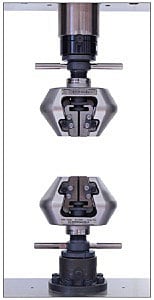Manual Non-Shift Wedge Grips
Manual Non-Shift Wedge Grips

Features:
- Applicable for testing a wide variety of materials, including metals, plastics, lumber, and composites
- Self-tightening action minimizes specimen slippage
- Standard grips with maximum capacity up to 300 kN (66,000 lbf)
- Additional wide grip face (50 mm, 2.0 in) grips available
- Grips operated manually by the use of a handle
- Compatible with a comprehensive selection of grip faces for testing rods, wires, materials with high hardness, and composite materials
Relevant Materials:
Plastics, Metals, Lumber, Composites
Relevant Specimens:
Plates, Rods, Wires
Manual non-shift wedge grips are versatile grips for tensile testing a wide variety of materials, including metals, plastics, and composites. The open-front design allows easy insertion of specimens and exchange of grip faces. The self-tightening action means samples are held firmly within the grip faces, minimizing slippage during testing.
Each manual non-shift wedge grip set includes upper and lower grips and file-teeth grip faces for flat plate specimens. Standard grip sets are available with maximum capacity between 5 kN (1,100 lbf) and 300 kN (66,000 lbf). In addition, grip sets are available with wide 50 mm (2.0 in) file-teeth grip faces for grips with maximum capacity between 5 kN and 100 kN (22,000 lbf). Grip sets of 250 kN (55,000 lbf) and 300 kN are supplied with 50 mm file-teeth grip faces as standard.
A comprehensive selection of additional grip faces can be found in the document on Grip Faces for Manual and Pneumatic Non-Shift Wedge Grips. Options include grip faces especially designed for rods, wires, materials with high hardness, and composite materials.
News / Events
-
AUTOGRAGH AGS-X2 Series has been released
The Shimadzu AUTOGRAPH AGS-X2 series provides superior performance and practical testing solutions for a wide array of applications. Offering high-level control and intuitive operation, the AGS-X2 series sets a new standard for strength evaluations while providing the utmost in safety considerations in a modern, stylish design.
-
AUTOGRAGH AGS-V Series has been released
Shimadzu Corporation released the Autograph AGS-V Series precision universal testing machine. In this series, the range over which the force measurement accuracy is guaranteed has been increased by a factor of two compared with existing machines. As a result of this new function, the work required to change force measurement sensors and accessories required for measurement can be reduced.
-
High-Speed Video Camera HyperVision HPV-X3 has been released
Recording speed of 20 million frames/second, the highest in its class provides larger, clearer, high-sensitivity recording. HPV-X3 is equipped with a synchronized recording function and high-level analytical capabilities that accommodate a variety of software programs.
-
New Video: AUTOGRAPH AGX-V2 Voice Operation Device XV-Talk
We will introduce how XV-Talk, the world's first voice control device installed in Shimadzu's latest tensile tester AGX-V2, can be used in various scenarios.
-
New Video: AUTOGRAPH AGX-V2 Operation Control Panel Stand-alone test feature
We will introduce a new feature of Shimadzu's latest tensile tester, AGX-V2, a stand-alone testing function using a large color LCD touch panel.
-
New Autograph AGX-V2 Series Precision Universal Testing Machines
The World’s First Testing Machines Equipped with a Voice Operation Device


